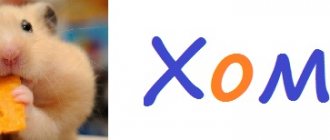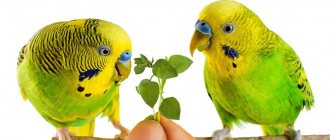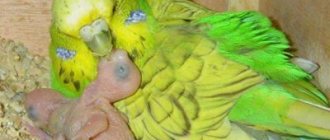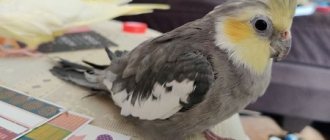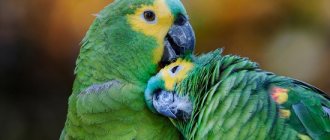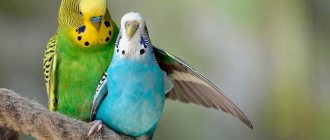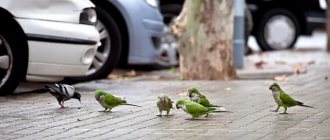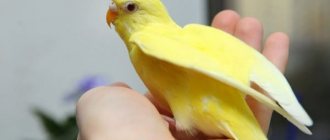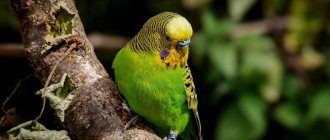Category: Articles
When choosing a budgie, we are faced with such a wide range of different colors that we can get confused. The color of these unusual bright birds is striking in its variety of shades and richness.
In the wild, the “natural” color of a budgerigar is light green.
Photos of green budgies:
Since both the male and female budgerigar have the same color genes, the chick turns out to be similar to its parents. Of course, in nature there are also deviations from the standard colors - this is explained by the receipt of different hereditary characteristics from the couple. As a rule, such a bird does not survive: the color of its plumage is a signal for predators and does not save in an emergency situation, and a flock of parrots can kill “not like everyone else.” Nature thus selects the most adaptable hereditary traits, thanks to which the bird has a chance to survive in the wild.
Domestic budgies owe their color diversity to humans. They feel great under appropriate conditions. Different plumage colors do not in any way affect their quality of life and relationships between relatives.
A Brief History of the Color Genetics of Budgerigars
Through long-term selection, at present, in the colors of budgerigars, there are about 32 primary mutations, which in turn give more than a hundred secondary ones. It took scientists many years so that today we can enjoy the incredible variety of colors of budgerigars. Thanks to the laws of inheritance, breeding a particular color now becomes possible even for ordinary bird lovers.
In 1872, as a result of long work, breeders managed to breed a yellow budgerigar. And only in 1878. Belgian scientists introduced the blue budgerigar to the world, but offspring of this color were obtained only in 1910.
Photo of a blue budgerigar:
Thanks to the blue wavy, dark blue and dark green parrots were born.
Photo of a white budgie:
White budgerigars were bred in France in 1917, and 7 years later albinos appeared in Germany, and parrots of variegated colors appeared in Denmark. We owe the purple and brown colors to England.
April 1, 1994 The World Budgerigar Breeders Organization (WBO) was created, which prescribed standards used both at exhibitions and in everyday life to guide the genetic colors of budgerigars.
Budgerigars with mixed genes
The incredible number of existing colors confirms that budgerigars are an excellent species for breeding. Most artificially obtained colors can be mixed, because birds have a special genetic predisposition to this. If the parents have a similar genotype, then their chicks will have more pronounced dominant traits.
On a note! Gene mutations give beautiful, unusual colors, but affect the health of birds. Artificially bred parrots often get sick and live shorter lives than individuals with natural feather color.
Purple factor
Only by delving into the genetic subtleties can one understand the specifics of obtaining blue and purple budgies. Their appearance is based on a primary mutation of normal color. A bluish tint occurs only if there is a violet factor in the genes. Moreover, the final coloring will range from lilac to bright blue. It also depends on the gray factor.
Visually, three combinations can be distinguished:
- purple blue;
- single-factor cobalt;
- two-factor cobalt.
These combinations were fixed by the WBO organization when working on the table of Standards. The level of color change depends on the set of genes of a particular bird. The main features of a parrot with a violet factor are similar to those possessed by blue or cyan representatives: the same spots on the beard, a white base, a black pattern on the back and wings, and a blue-green tail.
WHOVP Standards
We will look only superficially at the classification of wavy colors, since this is a whole science and for a more in-depth study it may take much more time. A person who has never delved into the genetic characteristics of colors until now may simply get confused in the variety of groups and subgroups of budgerigar colors.
| Groups of budgies | Photo of the group representative |
| Normal green budgerigars | |
| Opaline budgies green and blue row | |
| Cinnamon budgies of the green and blue row | |
| Opaline cinnamon (Opaline Cinnamon) green and blue budgerigars | |
| Lutino and albino (Lutino, Albino) | |
| Clearwings Yellowwings and Whitewings | |
| Crested variety | |
| Spangle (Spangle) budgies of the green and blue row | |
| Pied budgerigars of the green and blue series | |
| Yellowface | |
| Greywing budgerigars of the green and blue series | |
| Fallow budgies of the green and blue row | |
| Clearbody budgerigars of the green and blue series | |
| Saddleback budgerigars of the green and blue row |
There are “Normal” colors and patterns. Scientists decided to call the light green color of the first parrots imported to Europe Normal color The normal pattern of a parrot is the standard black waves that accompany the original appearance of budgerigars.
The group of Normal green budgerigars includes: Light Green, Dark Green, Olive Green, Greygreen, Skyblue, Cobalt, Lilac (Mauve), Violet (Violet), Gray (Grey).
Future color of the offspring of budgerigars
In order to at least slightly predict the color options of the chicks from your pair, you need to determine what the main color of your wavy is.
Green parrots have a natural base color of yellow. Blue parrots have white.
There is also a Parblue species between the Green and Blue rows of parrots - these are the Yellow-faced and Golden-faced parrots.
The color of green budgies is dominant during breeding.
Parblues are dominant to Blue parrots, but recessive to Green parrots.
Blue budgies are recessive to other colors.
Interestingly, the part of the spectrum in which parrots see each other is ultraviolet and their colors are much brighter than a person can see. Moreover, if you look through the eyes of a parrot at another budgerigar, you can see that the radiance of the bird is provided not only by the color of the plumage, but also by the wax and paws, which are cast in an azure color. The budgerigar's cap also attracts the eye with its unusual shine.
During mating and courtship, birds try to show themselves in all their glory. The brightness of the male's plumage plays a decisive role for the female.
popugai.info
Character and behavior
The budgie has the character of a little robber who can quickly create a mess in the room if you leave something untidy (notebooks, newspapers, textbooks). Therefore, it is necessary to leave several toys in the cage (hang a bell, a mirror, small plastic objects), which will brighten up a boring environment. The bird loves neatness; the cage may be small, but clean. The wavy, rainbow pet will thank you.
Even a mild illness can cause sadness; you need to take care of your pet.
Little tomboyish birds cannot resist anything that can be torn. You need to be careful with school notebooks. If the sheets depict cells and lines, you should not allow the bird to tear the sheets with its beak, since the paint contains lead toxins, which can cause the pet to be poisoned and die. You should not give rainbow parrots newspapers to play with; lead ink, once in the stomach, can cause a serious illness and death of the bird.
Basic colors of budgerigars
In the process of domestication, the colors of budgies became very diverse, ranging from very bright colors to delicate light shades.
The main colors of these birds are:
- Light green
- Dark green
- Blue
- Olive
- Pink and purple
- Cobalt
- Grey
- Violet
These colors are found in the plumage of parrots more often than others. Sometimes, due to a certain combination of genes, new colors may appear. One of the latest colors released is anthracite. Parrots with this coloration are almost completely black and have already become a favorite among breeders, as their appearance is unusual and unique. Photos of budgerigars of this color quickly spread on the Internet, and owners never cease to pester them with questions about breeding such budgerigars.
Types of colors of budgies
There are many types of coloring:
1. Standard - representatives of this color have a slightly lighter mask than the rest of the plumage, six throat spots, as well as uniform stripes on the back.
2. Opaline - such wavy stripes do not have clear equal stripes on the back and back of the head. A distinctive feature of this color is the intensity of the stripes, their absence and the color of the mask, spreading to the top and front of the head, after which it is covered by weakly colored waves, resulting in gradation, the color is mixed with the main one. Birds with this mutation usually have black or dark gray wing markings that may overlap with the dominant white and yellow pigments in the plumage.
3. Star-shaped, also called "Spangle". These are individuals with a lace pattern on the tail and wings. The feathers are not black, with a lighter border, like those of the familiar budgerigars, but, on the contrary, white with a dark border. Birds with this mutation have a recessive modifier, that is, a lightening agent necessary for two-factor spangles. A similar phenomenon exists only in this type of mutation.
4. Cinnamon - instead of black, there is brown in the plumage. Males have much darker markings than females, which makes it easy to determine the sex of an individual. An interesting feature of cinnamon parrots, namely their chicks, are their eyes, which have a pronounced plum color, distinguishing them from ordinary chicks with black eyes. But this can only be noticed during the first few days after their eyes open, then they darken and become a more familiar black color.
5. Yellow, also known as yellowface. In such parrots, yellow can be present either only on the face, or spread evenly throughout the body, while being on the face too.
6. Grey-winged - the wings, regardless of the color of the plumage, remain completely gray.
7. Clearwings - wavy birds of this type have a fairly uniform yellow color of the wings with green plumage, and white with blue-blue color.
8. Variegated - there are quite a lot of such colors. Most birds have bright spots of various shapes on the body, some have only one spot on the back of the head.
9. Half - similar colors in plumage cannot be inherited, because of this, half is considered one of the rare colors of budgerigars.
Budgerigars with mixed genes
Most of the existing colors and patterns of budgies can be mixed with each other. If the chick's parents have the same genes, then the inherited dominant traits will be twice as pronounced.
There is a color called “albino”, resulting from the crossing of two birds - Spangles. Such wavy birds have completely white feathers, as well as dark eyes, which are the only distinguishing feature from full albinos.
Unfortunately, birds with mutated genes often have poorer health and shorter life spans.
Parrots live the longest, with a more natural plumage color.
Purple color of parrots
The purple budgerigar, a photo of which owners often take in order to show off their beautiful pet, can have a color from heavenly lilac to rich blue and, directly, violet.
The violet color factor affects the color of birds, despite the fact that to obtain such a color a gray dominant gene is necessary. The degree of brightness and color change depends on whether the parrot has a single or double violet factor, as well as on the presence of dark and blue factors. There are eighteen varieties of this mutation, but only three of them can be classified as purple by established show standards.
Budgerigars with rare mutations
There are several types of rare mutations:
1. Crested. In representatives of this mutation, the feathers on the head grow randomly, forming a crest. Some crested birds have tufts of feathers growing chaotically on their wings and back.
Divided into three types:
- with a round crest;
- with a semicircular crest;
- with a tufted bun.
2. Rainbow - individuals with an unusual combination of colors and waves, among which there are very bright colors.
3. Saddlebacks. These wavy cats were bred in Australia and are distinguished by dark gray markings in the saddle area and a minimal amount of them on the head.
There are countless varieties of color and mutations due to which they appear, but it is important to remember that if you want your bird to live as long as possible and be completely healthy, it is better to give preference to individuals with a color close to natural, that is yellow and green. Parrots that have suffered gene mutations may be weaker and less active than their wild counterparts, with less extravagant feathers.
moikesha.ru
Birds with plumage of a special combination of colors and waves are called " Rainbow ". This name was given by the owner of Keston Foreign Bird Farm in Kent, England. The owner was not the first breeder to breed birds of this color, but he was the first breeder to breed the most colorful combinations and began selling such birds.
The Budgerigar Breeders' Society (UK) defines these birds as Yellow-faced (or Golden-faced) Opaline White-winged Blue .
The blue can be Sky Blue, Violet Sky Blue, Cobalt, Violet Cobalt, Visual Violet, Lilac or Violet Lilac.
Now, finally, after almost half a century, the Budgerigar Breeders' Society has recognized all variations of Yellowfaces and Goldenfaces (without lumping them into a single mutation, as was previously the case), describing official standards for them all in their 1994 Color Standard Book. Also published standards for Rainbow and Golden-faced Rainbow variations.
To classify a parrot as a Keston Rainbow, the bird must belong to the Type II Yellowface variety; The plumage of Golden-faced Rainbows (a similar mutation) is a deeper yellow. To develop these complex variations, the breeder used Australian Clearwings (imported from Australia), Australian Opaline mutation birds (not Scottish or European mutations), plus Type II Yellowfaces of English origin.
To produce Golden-faced Rainbows, he used Golden-faced Blues from Australia instead of Type II Yellowfaces. Nowadays many birds exhibited as Rainbows are Type I Yellowfaces as for many years this was the only Yellowface mutation recognized by the Budgerigar Breeders' Society of Great Britain.
In Type I Yellowfaces, the yellow color is limited to much smaller areas than in Type II Yellowfaces and Goldenfaces. Therefore, for breeding exhibition Yellowfaces, Gray Normals, Opaline, Type I Yellowfaces are preferred. In Rainbow breeding, Type I Yellowfaces help provide larger size and other desirable show qualities, but such birds are not as showy as true Rainbows and Goldenface Rainbows. However, since they are recognized by the Budgerigar Breeders' Society, they are shown in the same classes, and it must be said that most judges give preference to size and other show qualities rather than brightness of color, and therefore such birds often receive awards.
As mentioned, blue body color can vary widely from Sky Blue to Violet Lilac. Gray birds are also part of the blue series, but are usually excluded from the Rainbow breeding program, as the word "rainbow" implies colorfulness. Slates fall into the same category as Grays.
The True Rainbow or Golden-faced Rainbow is a bird with a yellow or yellow-gold colored head and mask; body color varies from sky blue to violet and lilac, with an area of green with varying depth of color where the yellow of the mask fades into the blue of the body; the opaline "V" zone produces a blue mantle; the color of the wings is off-white (off-white), with blue, green and yellow markings with an iridescent effect; off-white (off-white) or pale gray flight feathers. The tail feathers are mostly a deep blue, but with lighter areas tinged with yellow. Shorter tail feathers carry less blue and more yellow. As expected, when the dark and/or violet factor is involved, most colors and markings become correspondingly darker.
Type II Yellowfaces and Goldenfaces can add greater intensity to all colors. The golden-faced mutation can even give some wing markings an attractive bronze color, the closest thing to red we can get. But do not confuse this with the Cinnamon mutation, which should definitely be avoided when breeding Rainbows and Golden-faced Rainbows.
Birds with "Buff" plumage do not show the true color vibrancy of true Rainbows, and therefore most Rainbow breeders prefer birds with "Yellow" plumage.
It is generally accepted that the most colorful bird of all the variety is the Golden-faced visual Violet Rainbow.
There are many ways to combine mutations to produce a pair suitable for breeding Rainbows or Golden-faced Rainbows. One way to breed with Type I Yellowfaces is to start with a Blue Opaline male and a Whitewing female, and a Whitewing male and a Type I Yellowface female. Some chicks from these pairs, when brought together the following year, may produce Rainbows.
Some combinations that will result in Rainbows involving Type I Yellowfaces:
1. Yellowface Whitewing/Opaline Male – Whitewing Female
2. White-winged Opaline male – Yellow-faced White-winged female
3. Yellowface / Opaline Male – Whitewing Female
4. Whitewing/Opaline Male – Yellowface/Whitewinging Female
siniy-popugay.ru
Multicolored lorikeet: interesting facts about the parrot
- "Lori" means "clown" in Dutch.
- other name: multicolored lorikeet
- create a married couple once and for all
- Lorises have been bred for over 150 years
- love to eat sweets and swim
| Origin: | New Guinea, northern and eastern Australia, Solomon and Goali Islands, Tasmania, New Caledonia and the New Hebrides. |
| Classification: | Parrots, 21 subspecies |
| Color: | What color is there! Bright blue on head and belly; orange on the chest and in several feathers on the legs and wings; green flight feathers, “panties” and the lower part of the tail; yellow “kokoshnik”, tail feathers and inner feathers on the wings. |
| Compatibility with other parrots: | Can only be kept with other lorikeet species. Other parrots show excessive aggression. |
| Size: | 28-30 cm |
| Friendliness: | Active, friendly people. Sometimes they show fearfulness. |
| Lifespan: | Up to 20 years |
| Average price: | 20,000 rubles |
| Other names: | Trichoglossus haematodus, multicolored lorikeet |
| Breeding: | Bred in captivity since 1868. They quickly adapt to breeding at home. They create a mate for life. Only two chicks are produced per clutch. |
| Content Features: | They eat flowers of rose hips, hyacinths, dandelions and chamomile. They love nectar and pollen. |
| Interesting fact: | Often, growing chicks want to return to the nest and this causes aggression from their parents. It is worth closing the nesting house or moving the family to another cage. |
| Speech learning ability: | They have a ringing voice and are reluctant to repeat words. |
Rainbow lorikeet
Watch the video: how the rainbow lorikeet plays:
Author of the article
Looking for a feathered friend? Then pay attention to the guest from the Green Continent - Australia and the islands of Oceania, the owner of an exotic color to match the name - the rainbow lorikeet. Under natural conditions, the bird lives in tropical rainforests and is found in latitudes from New Zealand to Hong Kong (where it was introduced later). Lorikeets are often chosen as feathered friends!
The parrot grows up to 25-30 cm in length, including its tail - not the smallest and not the largest of the parrots. It has a rich blue head, a beautiful yellow-green collar on the back of its head, and its back, wings and tail are pungent green. The chest is red and blue, the belly is dark green with yellow splashes on the rump and thighs. It is almost impossible to visually distinguish the sex of a bird, so if necessary, a special test can be performed. In captivity, with good maintenance, lorikeets live up to 30 years.
How to keep a rainbow lorikeet at home. In the wild, these birds live in pairs, often gathering in flocks to fight off larger and more predatory birds. It is preferable if you buy a pair right away, and there will be no cages with other birds nearby, otherwise the lorikeets will fiercely defend their territory.
There is a rather serious drawback: due to the peculiarities of their diet, the droppings of these birds are very soft and easily pollute not only the cage, but everything around. Therefore, you cannot do without additional plastic lids around the cage in order to somehow minimize the mess. In general, it is better to keep lorikeets not in a cage, but in an open enclosure, where the birds will enjoy flying and climbing plants and trees. By the way, be prepared for the fact that they may soon be destroyed. Lorikeets simply love to chew, so having edible chewing poles in their cage or enclosure is almost a must. You can cut such perches (twigs) yourself, preferably from fruit trees, but only if they have not been treated with chemicals.
It is necessary to provide a separate box “nest” in the cage, where the birds will spend all their time (excluding, of course, the breeding season). Lorikeets are characterized by good health, so they are not afraid of short-term frosts.
These parrots are very active and inquisitive birds; they love to explore the surroundings of the place where they live. If you are patient and constantly work with them, they will become completely tame and will accept food from your hands. Some individuals are distinguished by rich facial expressions and the ability to imitate onomatopoeia, and can learn several simple words. At the same time, individual lorikeets can be quite vocal, which can affect the sleep and peace of your neighbors!
In addition, lorikeets simply love to swim! Therefore, put a bath in the cage with clean and fresh drinking water - they take baths several times a day.
How to feed rainbow lorikeets. Their main diet is fruits, nectar and pollen. Nectar from eucalyptus flowers and other exotic plants in their habitat is especially tasty for them.
In captivity, mixtures specially developed for these birds and ready-made nectar are suitable. It is important to ensure that they have fresh fruit in their diet. You can give some oats, edible flowers and green vegetables from time to time for variety. Pet stores also offer ready-made dry granules for lorikeets, but in this case, the birds’ droppings will become completely watery, since they will drink these granules with an increased amount of water and, as a result, you will get such liquid droppings. Of course, it is possible to switch parrots to completely dry food, but in this case, along with hard droppings, we will also get constant constipation, which will affect the health of the birds.
Some breeders share their experience that ready-made fruit mixtures from baby food are perfect for lorikeets. Well, you can occasionally give such mixtures, but you should choose those that contain a minimum of sugar. We recommend, however, fresh fruit with grains from which these same grains have been previously removed.
Funny and educational stories about your pets -
subscribe to our channel!
Where are dogs' belly buttons?
How to make friends between a cat and a dog? Why does a hedgehog laugh? The entire encyclopedia about animals is on our website.
Budgerigars are the birds that breeders love to work with. Counting the exact number of budgerigar species is incredibly difficult. There are many colors, shapes and colors of plumage. There are 32 primary mutations and more than a hundred secondary ones. Today we will talk about the most common breeds of wavy cats, and also look at several unusual colors.
Clear-winged parrot and lutino
Distinctive features
Exhibition budgerigars reach 29 cm, the standard is 24.5 cm. They have a fluffy cap on their head, a long beard and beautiful beads. But this is only if the pet is of a standard color. The beak is hidden by a beard. The bird's posture is proud, its chest is pushed forward, and its head is held in such a way as if its winged friend is wearing a crown.
Plumage color
Colors can be very different. In addition, selection is regularly carried out in this direction. Exhibition budgerigars can vary in type. These stunning, graceful birds are constantly improving. Every day there are different types of parrots.
Character
Feathered exhibition species of parrots have a calmer character. They don't chirp much. However, they are able to speak a lot and clearly. In the mornings their activity is quite low. They calmly wait for their owners to wake up. Having a large body mass, show budgerigars fly very little, as they get tired quickly. But at the same time, they are fun to play and communicate with. Sometimes they can show their restless nature during exhibitions. In this case, the judges use special sticks, with the help of which they can distract the bird’s attention and force it to sit quietly for a while.
Training and breeding
Show birds are usually sold as tame birds. Accordingly, it will be easier to teach them to talk. For training, it is worth taking a chick that has recently left the nest. Its age should be 40-50 days. It is necessary to understand that the longer a bird has lived in a flock, the less likely it is to become tame by teaching it to speak.
Exhibition parrots are less fertile. If you decide to breed them, you need to prepare separate enclosures for each pair. Parents may stop feeding their chicks. This responsibility falls on the owner of the birds. Chicks must be ringed using European standard rings. You will need to indicate the serial number, year of brood and country. This is required for breeding and exhibition work.
The video will demonstrate how a parrot is tamed.
Care
Show parrots require larger cages with thicker perches. The feeders should also be large. In ordinary ones, parrots can get stuck and die from suffocation. The distance between the rods should not be more than 1.5 cm. Otherwise, the curious chick will stick its head in, but will not be able to stick it out. The cage tray should be high so that the parrot can stretch its wings.
Feeding an exhibition parrot requires only high-quality dry food, vegetables, fruits, mineral stones, fresh water and vitamins. You can use honey sticks. Be sure to feed sprouted wheat, filling it with water first. Calcined cottage cheese will bring benefits.
Varieties of parrots
What types of parrots can be distinguished? There are many of them. Some bird species can be seen in the photo. In this review, only the main varieties of feathered pets should be highlighted.
Single color
The color of this breed of parrots is dominated by one color. For example, green, blue, cyan, purple or yellow. If the color is green or blue, the bird has normal plumage. In the case when the color is white or yellow, the plumage is distinguished by pale wavy. Representatives whose color is ash-gray have black undulations.
Multicolor
Rainbow budgies. These types of pets differ in that the color includes different colors, which are distributed almost evenly. Parrots of this breed are divided into pieds, penguins and harlequins.
Pieds can be dominant or recessive. They differ in that the colors (there can be about 6 of them) are distributed chaotically throughout the plumage.
Harlequins are distinguished by the fact that the coloring on the chest and belly is well demarcated. For example, if the sternum is blue and the belly is yellow, then this parrot is called a blue-and-yellow harlequin. Males have red skin, while females have a shiny, waxy skin.
In penguins, the upper part is separated from the lower part. The name of the bird will depend on the flowers.
Birds with a crest
Crested talking parrots differ from other breeds of parrots in that they have a crest on their heads. It can have different shapes and degrees of crestedness. The colors are also different.
Arrangement of the nest
The beginning of nesting is regulated by installing nesting boxes in the cage. The cage must be spacious, at least 45x45x45 cm. The nest is 25 cm high with a bottom 15x15 cm and is located vertically; horizontal installation is possible. You need to pour sawdust into the nest.
If the couple is chosen correctly, their mutual sympathy will manifest itself in the form of love games, accompanied by gentle chirping. In this case, the first egg will appear 2-3 weeks after the nest is placed. There are an average of 6 eggs in a clutch; the female lays one egg daily.
The chicks begin to hatch after 18 days. They acquire feathers at the age of one month. After their first molt at three months of age, their plumage will become more vibrant. Juvenile molt coincides with puberty and lasts about three months. After its completion, it will be possible to conclude whether the pet is rainbow.
It is difficult to purchase a rainbow budgie at a pet store. Breeding this rare beautiful variety of “wavy” is usually done by amateurs; the bird costs about 5,000 rubles.
Amazing and vibrant colors
Most often, parrots are light green in color. In 1972, a bird was bred whose feathers were colored yellow. A few years later a blue tint was obtained. Work is ongoing at the present stage. Now there are birds whose plumage is purple or black. It is necessary to highlight the primary colors that predominate in the plumage of feathered friends.
Combinations with green
The light green color is the original color. Parrots of this particular color were first brought to Europe. Over time, we managed to make the green tint combine with other very different shades and patterns. Therefore, now you can find birds whose plumage includes green, yellow, blue, purple, gray, black colors and various patterns.
Blue color with various shades
The body of the bird can be painted blue. On the head there will be a mask painted white. Blue and purple colors can be combined in plumage. There is also a gray tint. There are parrots with a dark blue, purple belly, chest or back. The flight wings are painted black.
Blue and purple feathers
There are species of birds whose back and chest are colored blue. The plumage may include white, black and gray colors. The waviness of the pattern is practically absent in this variety of feathered friends. It is not uncommon to find parrots whose plumage is half blue. The other half is white.
Parrots may have purple colored lower backs. The chest and stomach can be the same shade. Even the cheeks may have a purple tint. Some species have black spots, bluish feathers, a blue-green mask, etc. There are many variations. The black pattern can be located on the wings or head.
White and yellow pets
There are budgies whose plumage is completely yellow. The photos presented in the review serve as proof of this. There are also parrots whose plumage contains pink. There are also birds that combine yellow, gray, white and blue shades with each other. There is also purple color in various patterns.
There are parrots whose plumage is completely white. The tail may have a light gray tint. The cheeks can turn a pale gray tone. Birds may have wavy patterns on their backs, as well as on their heads, necks and cheeks.
Feathers can be different
There are birds whose plumage is colored light green. The mask can be yellow. The cheeks are colored purple, and the tail is dark blue with a brownish tint. A wavy pattern can be present on the neck, head, and cheeks. Males have a brown cere, and females have a blue one.
Albinos and lutinos: what are they?
There are breeds such as lutino and albinos. The lutino color allows for any shade of plumage, both light yellow and bright yellow. White color is present in the flight and tail feathers. In some cases, they may have a yellowish tint. In the area of the cheeks, lutino has a predominant pearly white tint.
The beak and paws are light. There is a red tint to the eyes. The iris is also light. Lutino males and females differ in the shades of their cere. In females it is brown. The cere of males has a pink tint.
Albinos arose when it was decided to cross breeds such as lutino and budgerigars, whose color was predominantly blue. The result is an albinos with white feathers. A distinctive feature should be considered red eyes with light paws. Pink color of the cere in males. Albino females are distinguished by their white waxes.
Genetics
If we talk about how budgies live in nature, then their coloring serves as camouflage: the grass-green color of the feathers allows them to hide in the foliage. The facial mask and goiter are colored yellow. A black pattern in the form of waves runs from the top of the head along the back. There are black or dark purple spots on the cheeks - distinctive marks characteristic of all budgerigars. The feathers on the wings and tail are much darker than on the belly.
Attention! Genetic abnormalities occur when a pair of birds hatches a chick with a non-standard coloring. Most often, such birds are doomed to death, since their relatives show aggression towards them and beat them to death.
House cricket (house cricket) - description, appearance, characteristics.
House crickets are fairly small insects. The size of the slender, slightly flattened body, covered with a hard chitinous shell, in adult individuals ranges from 16 to 26 mm in length. The color of the domestic cricket can be grayish-yellow, straw-fawn or various shades of brown with streaks, specks or spots of indeterminate shape.
On the head of the cricket, which resembles a flattened egg in shape, 3 dark arcuate stripes are clearly visible. The small eyes located on its sides have a complex facet structure. The mouthparts of crickets are of the gnawing type in structure. The antennae, consisting of several segments, are an organ of touch. Often their size is slightly greater than the length of the cricket's body.
The rear pair of well-developed membranous wings helps house crickets easily fly from place to place. At rest, the cricket's wings lie along the abdomen and resemble long, sharp tails. If necessary, house crickets can travel quite long distances. When the insect is on the ground, its wings are reliably protected from damage by dense elytra that lie flat on the back, with the right one slightly overlapping the left.
Like all orthoptera, the house cricket has 3 pairs of legs. The hind legs have thickened thighs and are designed to perform fairly long jumps. It is noteworthy that the hearing organs of these insects are located on the shins of the front pair of legs. The paired appendages located on the last segment of the abdomen are quite long and resemble peculiar antennae sticking out in different directions.
Sexual dimorphism is expressed in the presence of a special sound apparatus in male crickets, which is similar in structure to the sound apparatus of grasshoppers, but differs from it in greater complexity and a different arrangement of components. The stridulatory vein, which functions as a closure, is located on the right elytra, and the vein against which it rubs is located on the left elytra. When they rub against each other, the familiar trill of a cricket appears. In crickets, the sound apparatus is more developed and occupies a larger area than in grasshoppers.
Female crickets have an ovipositor at the very end of their abdomen, shaped like a spear. Its length ranges from 11 to 15 mm. With the help of this organ, females dig holes in the soil into which fertilized eggs are laid.
The average lifespan of a house cricket rarely exceeds 3 months.
Where does the house cricket live?
The house cricket lives in countries such as Egypt, Morocco, Sudan, Libya, Tunisia and Algeria. The insect is often found in Russia, France and Germany, Belarus and Poland, Romania, Italy, as well as in other European countries. Large populations of this insect are recorded in India and Pakistan, China, Korea, Japan, as well as in southern Australia. Recently, the house cricket has been living on the North American continent, where it was brought from Europe.
The main habitat of house crickets is human dwellings, warm basements, warehouses or industrial premises, as well as heating power lines. In temperate latitudes, with the onset of a warm period lasting from late May to mid-September, the house cricket can live outside buildings. The optimal conditions for the life of these insects are temperatures from +30°C to +35°C. When it gets cold, they find cozy shelters in any heated buildings, because when the ambient temperature drops below +21°C, crickets stop eating, become apathetic, move little, and the growth process of the larvae stops.
Diseases
Only when the immune system is weakened does the body become susceptible to various diseases (worms, salmonellosis, chlamydia, intestinal infections, inflammatory processes, tumors). If the bird is not feeling well, it does not eat well and refuses to take fluids.
If your wavy pet is ruffling its feathers and sitting in one place with its eyes closed, it is necessary to take the bird to an ornithologist or veterinarian for diagnosis and subsequent treatment.
The wavy, rainbow-colored pet is experiencing a difficult illness; care must be taken, otherwise the bird may die.
A bad symptom is trembling in the body and refusal of fluid; in this situation, it is necessary to show the parrot to the doctor, which can save his life. The cause of this phenomenon may be infections, vitamin deficiency, overheating, or the presence of cold symptoms. A bird can easily catch a circovirus, which attacks the parrot's immune system.
Main symptoms: white droppings, lethargy, weakness, decreased quality of plumage, feathers that easily come off the body.
Treatment is prescribed by a veterinarian, recommending antiviral and immune-strengthening drugs. Parrots can become infected through contact; the sick individual should be moved to another cage to minimize the risk of spreading the disease. A person does not get sick with the latter type of disease.
You can get chlamydia, toxoplasmosis and salmonellosis from your pets. For prevention, you can take metronidazole.
What does the house cricket (house cricket) eat?
Under natural conditions, the basis of the menu of house crickets is any plant food. However, insects require protein supplements in their diet. They satisfy this need by attacking small invertebrates, eating dead insects of other species, or even attacking their own kind. Quite often, young individuals of crickets become an additional dish for an adult relative, and eating egg clutches is common.
Once in human homes, crickets gain access to a limitless source of food. House crickets enjoy eating pieces of vegetables, fruits or bread crumbs left after breakfast, lunch or dinner. If a cockroach or other small insect gets in the way of a house cricket, it will certainly become part of its diet. No less attractive to crickets are droplets of any drinks consumed by humans, with the exception, of course, of alcohol.
Reproduction of house cricket.
The male brownie cricket is an insect that lives strictly in a certain territory and jealously guards its harem, consisting of several females. When a stranger enters the territory, fierce fights occur between males. An indispensable attribute of mating games is the singing of crickets, and if the conversation between males is carried out in sharp, abrupt trills, then the serenades that the gentlemen perform for the females sound quiet and melodious. Sometimes, thanks to such trills, female crickets can move to another, sweeter-voiced male.
House crickets do not have a seasonal rhythm in reproduction, so they can reproduce throughout the year. Moreover, females are able to mate several times before laying eggs. However, the peak of sexual activity still occurs in the summer. After fertilization, the female cricket, using an ovipositor, prepares holes in the soil into which it lays eggs that are shaped like a banana and have a length of up to 2.5 mm. One female is capable of laying from 40 to 179 eggs per season. If the average air temperature is 28°C, the number of cricket eggs can reach 725 pieces.
House crickets are insects that have an incomplete development cycle, consisting of only 3 phases:
- egg,
- larva,
- imago (adult).
The duration of the egg stage directly depends on the ambient temperature and can take from 35 days (if the air warms up to a temperature of 32°C) to 2 months (at an ambient temperature of about 27°C).
The emerging larva of a domestic cricket looks a little like an adult insect, but does not have developed wings and is not capable of producing offspring. In its development, it goes through up to 10 molts, occurring over 7 weeks, during which the body undergoes restructuring. A few days after the last molt, house cricket adults become sexually mature.
House cricket - breeding at home.
With the right approach, keeping and breeding domestic crickets is not particularly difficult. You just need to follow simple recommendations and remember that you need to use at least four insectariums to keep insects of different ages.
- A maximum of 15 females and a maximum of 3 adult males can live in one container.
- As an insectarium for home crickets, you can use containers made of glass, plastic or plywood with a height of at least 60 cm, with tight-fitting lids made of stainless steel mesh that provides good ventilation.
- Glass plates are glued to the inner surface of cages made of plywood, at least 15 cm wide from the top. This is done to prevent crickets from escaping from insectariums. In containers made of glass or smooth plastic, such a “security perimeter” can be created by smearing the inner upper part with Vaseline.
- Finely sifted peat, often mixed with sand, is used as a substrate poured into the bottom of the cage for home crickets. The layer thickness should not exceed 10 mm. To maintain the optimal temperature necessary for the normal development of insects, top heating of insectariums is used using ordinary incandescent lamps with a power of no more than 75 W or bottom heating carried out by a heating cable. The container for home crickets must be heated around the clock.
- In addition, it is necessary to maintain a certain humidity regime inside the cage. For adult individuals this figure should be no more than 40%, and for young larvae within 55-65%. In adults, moisture replenishment occurs through feeding with food with a high content of internal juices, and for young animals, a small irrigation of the substrate can be done with a spray bottle.
- Small glass containers about 6 cm high filled with substrate are also placed inside the insectarium, into which female house crickets lay eggs. The substrate with laid eggs is moistened a couple of times a day. As the container is filled with eggs, they are transferred to a special container that acts as an incubator. It constantly maintains humidity at 90% and a 24-hour temperature of about 28-30°C. After 5-10 days, the containers are moved from the incubator to a separate insectarium, in which, after the allotted period, the larvae are born.
Conditions of detention
Rainbow parrots can be kept in a cage or aviary. The cage in which one bird lives must be at least 40x25x45 cm. Place inside:
- perches;
- feeders;
- drinking bowl;
- bathing suit;
- toys (swings, ladders).
The diet of birds includes various types of grains and seeds (including sprouted ones), vegetables, herbs, fruits, berries, crumbly cereals, boiled eggs, and low-fat cottage cheese. Vitamins are added to the food. The cage should always contain mineral supplements (chalk, sepia), as well as branches of fruit trees or willow for grinding down the beak and claws.
For breeding, healthy birds of suitable morphs over the age of 14-16 months are selected. They are placed in a cage at least 60 cm long with a nesting house measuring 17x17x23 cm installed inside. The bottom of the house is lined with sawdust.
- Where do budgerigars come from or Australia as the birthplace of the parrot
Signs of birds' readiness to reproduce are the male's courtship of the female and the female's interest in the nesting house. A week after mating, the female lays a clutch of 5-8 eggs. Incubation lasts 18 days. At the age of 35 days, the chicks leave the nest, and after another 2 weeks they can be separated from their parents.
What to feed house crickets?
Any vegetable crops and herbaceous plants are used as food for domestic crickets. Beets, carrots, lettuce or dandelion leaves, and clover heads work well. Good results are obtained by adding amphipods (hamarus), pork or chicken feed, powdered milk, and oatmeal to the diet. It is better to give food to crickets in small portions every day, and food can be placed in shallow feeders for adult insects, and scattered along the bottom of the insectarium for young animals. The condition of the food is regularly checked: if it is contaminated with waste from domestic crickets, it is replaced.
